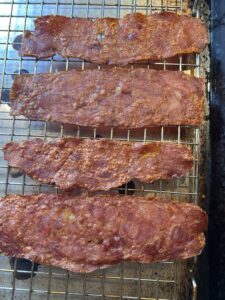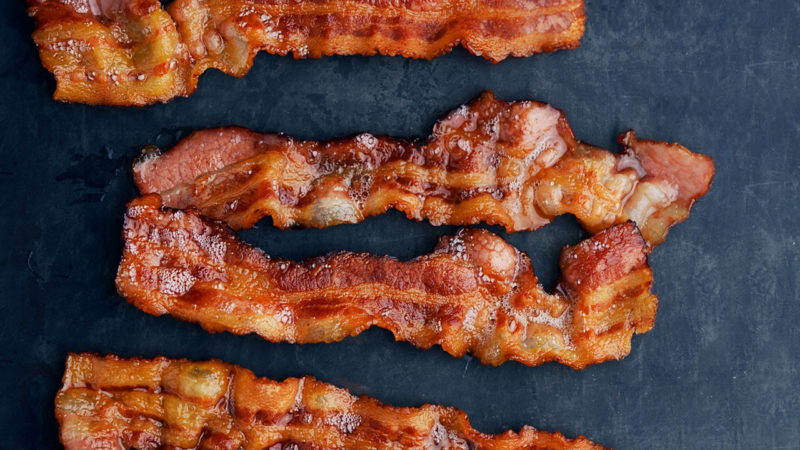Last Updated on January 27, 2025
They’re both called “bacon,” but they’re not the same. So how exactly are turkey and pork bacon different, and do they have similarities beyond the word “bacon”? We evaluated both in several ways to bring you everything you need to know, including how to cook them.
We cooked and ate a lot of bacon in researching this article (you’re welcome!), and one important conclusion we came to is: One type of bacon isn’t “better” than the other; both are delicious and satisfying. Depending on your personal preference, you may choose one or the other–or you might do what we do, and keep them both on hand.
What is turkey bacon?
ButcherBox turkey bacon is made from humanely raised birds fed a vegetarian diet. It’s made from turkey thighs, without added sugar, nitrates or nitrites.
What is regular bacon?
Our regular bacon, made from pork, is cut from the belly and sourced from heritage breed pigs. It’s sugar free and uncured, made without nitrates.
What’s the difference between pork bacon and turkey bacon?
Turkey bacon and pork bacon are both flavorful, rich and smoky. Both make a tasty side for eggs in the morning, both are great in a BLT, and both work well in recipes. But there are a few key differences between turkey and pork bacon.
- Nutrition. Here’s a basic nutritional breakdown for both (per 2 pan-fried slices):
- Turkey bacon: 80 calories, 3g fat, 12g protein, 0g carbohydrate, 380mg sodium
- Pork bacon: 140 calories, 14g fat, 4g protein, 0g carbohydrate, 340mg sodium
- Flavor. Pork bacon is saltier and smokier than turkey bacon. Turkey bacon is milder (though it’s still well seasoned and tasty).
- Texture. Turkey bacon is leaner, so it tends to be chewier than pork bacon. It is possible to make it somewhat crisp, but it doesn’t have the same snap that pork bacon has.
Can you swap pork bacon and turkey bacon?
You can substitute one for the other, especially if you’re eating bacon as is alongside eggs or another breakfast food.
If you’re using bacon in a recipe, it may require a bit of extra thought to swap them. For example, pork bacon is crisper and crumbles more easily, so it’s great for topping salads, mashed potatoes and other dishes when you want that crunch. To get similarly small pieces of turkey bacon, it’s best to chop it finely with a sharp chef’s knife. It may not be quite as crisp as pork bacon, but it will still be delicious.
How to cook turkey bacon
- In the oven: Preheat the oven to 400ºF. Line a baking sheet with parchment or with a wire cooling rack. Lay the bacon strips in a single layer on the parchment or rack. Bake for 10 minutes, then flip the bacon and cook 10 minutes longer. If you prefer it more crisp, flip again and bake it 3 to 5 minutes longer.
NOTE: The bacon on the parchment will be slightly less crisp, and the bacon on the cooling rack will be more crisp but also slightly drier. Both work, it just depends on your preference.

- In a skillet: Preheat a large skillet over medium heat. Add the turkey bacon in a single layer and cook, turning once or twice, until the bacon is golden on both sides, 7 to 10 minutes.
NOTE: For crisper slices, you can melt a teaspoon or two of butter or swirl a bit of olive or avocado oil in the skillet before adding the turkey bacon.
How to cook pork bacon
- In the oven: Preheat the oven to 400ºF. Line a baking sheet with parchment or a wire cooling rack. Lay the bacon strips in a single layer on the parchment or rack. Bake for 10 minutes, then flip the bacon. For bacon directly on the baking sheet, bake 5 to 10 minutes longer, depending on how crisp you like it. For bacon on the cooling rack, bake 10 minutes longer. If you like it crisp, flip again and bake for and additional 3 to 5 minutes.
- In a skillet: Lay the bacon in a single layer in a large unheated skillet. Place it over medium-low heat and cook, turning once or twice, until the bacon is crisp and the fat has rendered, 7 to 10 minutes.
How to use up bacon fat
When cooking pork bacon, you’ll be left with some rendered fat. Don’t toss it! It lends a subtle savory, smoky note to anything you cook with it. Strain it through a fine-mesh sieve into a cup or small bowl, then cover and refrigerate it.
Here are some uses for rendered bacon fat:
- Cook with it. Use bacon fat in place of some of the oil or butter in a recipe. Use it to make sauces or salad dressing, or toss vegetables in it before roasting.
- Grease a pan with it. Brush a baking dish or baking sheet with bacon fat instead of butter or oil to keep foods from sticking.
- Bake with it. Swap bacon fat for some of the butter in your favorite baking recipes. We love to swap it for half the butter when we bake chocolate chip cookies–or, make bacon the star, as in these salty-sweet bacon shortbread cookies.
Bacon recipes
Can’t get enough bacon? Same! Here are some of our favorite ways to use it:
- Chopped Bacon Salad
- Artichoke and Bacon Pasta with Herbs, Feta and Pistachios
- Candied Cajun Bacon
- Bacon Sautéed Green Beans
- Grain-Free Maple Bacon and Apple Dutch Baby
Beth Lipton is a Brooklyn-based recipe developer and writer specializing in food and wellness. Her work has appeared in Clean Eating, Paleo magazine, FoodNetwork.com, Well+Good, Outside, Sleep.com and more. Beth's latest cookbook, Carnivore-ish, featuring 125 animal protein-forward recipes, is available now.



